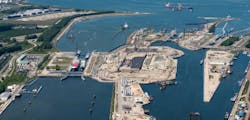Morning Mull: Relative Construction Costs and Land use of Solar, Wind and Natural Gas plants
Some interesting factoids on construction costs and land use of the three prenominant electricity generation resources in the U.S. I'd mulled them over and thought I could share with you, dear reader:
Nearly all new power generation added in the U.S. over recent years is either solar, wind or natural gas-fired power. All of these are significantly less carbon intensive than the one-time king of coal-fired power.
And the costs for these three dominant electricity generation resources is getting closer as ever, according to data from the U.S. Energy Information Administration. In 2020, the most recent figures available, solar power construction costs were the only one of the three to fall compared to the previous year.
In comparison, though, combined cycle natural gas turbine (CCGT) power plants are still the least expensive to build, but the gap between solar and wind is closing somewhat, according to the EIA data. Wind, solar and natural gas comprised about 98 percent of new electric generating capacity in 2020, at approximately $46.3 billion of total investment.
Average solar construction costs were the only one of the three dominant resources to fall in 2020, decreasing nearly 8 percent to $1,655 per kilowatt (kW) of capacity. Natural gas-fired CCGT construction, meanwhile, made up only 13 percent of that total investment, with costs increasing 22 percent (compared to 2019) to $1,155 per kW, the EIA report shows.
The cost of building utility-scale wind farm also rose in 2020, although the average construction expense for moderate-sized projects (100-200 MW) actually fell 5 percent to $1,531 per kW, making wind about $120 per kW less expensive than solar.
By comparison, there is a range of only $500 per kW construction cost difference between the three resources. Of course, over a 100-MW project that might be a total $500 million more expensive to build out solar and wind than same-capacity gas-fired CCGT plants.
The incentives such as production tax credit and future influx of appropriations from the Inflation Reduction Act and Infrastructure Act levels that playing field somewhat over the next decade or so.
Thinking about playing fields got me thinking about land, which got me to thinking about the footprint of solar, wind and natural gas power plants.
Land-wise, a typical 500-MW combined cycle gas power plant might take up five to seven acres. A 100-MW solar farm might be spread out over 1,500 acres, and a similar capacity wind farm could take 10,000 acres or more, according to various reports.
-- -- --
(Rod Walton, senior editor for EnergyTech, is a 14-year veteran of covering the energy industry both as a newspaper and trade journalist. He can be reached at [email protected]).
Follow us on Twitter @EnergyTechNews_ and @rodwaltonelp and on LinkedIn





